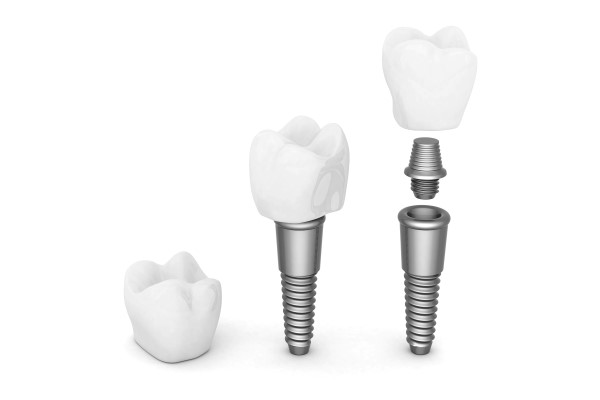Dental Implant Restoration -How Is a Dental Crown Attached to an Implant?

A dental crown replaces the missing tooth when it is attached as a dental implant restoration. With the tooth implant embedded in the jaw and the crown lying above the gum line, it is easy to wonder how the components connect. Crowns connect to dental implants with two main mechanisms, both of which will be discussed in this article.
Components of the dental implant restoration
The dental implant restoration is made up of three parts, including the dental implant which sits inside the jaw, the abutment (which connects the implant and the crown) and the crown or artificial tooth. The crown is the upper visible part of the dental implant restoration and it attaches to the implant through the abutment. It can be connected with screws or dental cement. Each option has its application, advantages and drawbacks.
Connecting a dental crown using oral cement
The dental professional can opt to connect the crown to the abutment using dental cement. It is often used for front-row teeth for cosmetic reasons. The dental cement used is tooth-colored, meaning that the front-facing dental crown will not experience the discoloration that sometimes occurs with screw-retained crowns. However, there are some downsides to using this technique.
A dental restoration attached using cement is expected to stay permanent on the jaw and not to be removed. However, for some reason, the implant crown may need to be repaired or replaced eventually. The adjustment would certainly require removing the crown, which would be significantly difficult because it was cemented to the implant. Removing the crown is challenging and will almost certainly require breaking it, which typically results in a need for replacement.
Screw-retained dental crowns
It is also possible to attach a dental crown by screwing it directly to the abutment. Considering factors such as longevity, ease of repair and the ease of application, connecting the dental crown with a screw is the preferred option to consider. The major drawback of using screws is that they are not as cosmetically-appealing as dental cement, which is the reason they are often used for the back teeth.
Some of the benefits of attaching a dental crown with screws include:
- It is safer to use screws for connecting same-day, implant-supported crowns
- It is easier to remove screw-retained crowns for repairs or replacement
- If a nearby tooth falls out, the screwed crown can be replaced with one that can support a dental bridge
Temporary dental crowns are used to get the gum tissue ready for the permanent crown. These crowns are retained using screws and are easy to remove when it is time to place the final crown.
In summary
The option that the dentist chooses for connecting the dental crown to a dental implant will depend on the patient’s unique case and preferences. The general dentist will walk each patient through the options and explain the advantages and downsides of each option. To learn more about dental implant restorations, contact the dental office to book an appointment.
Request an appointment here: https://www.mysaratogadentist.com or call My Saratoga Dentist PLLC at (518) 675-3094 for an appointment in our Saratoga Springs office.
Check out what others are saying about our dental services on Yelp: Dental Implant Restoration in Saratoga Springs, NY.
Recent Posts
A broken tooth can affect both oral health and confidence. Whether caused by biting into something hard, an accident, or underlying decay, prompt dental care is essential to prevent further damage and restore normal function. Fortunately, modern dentistry provides several reliable treatments that repair structural damage and rebuild a natural-looking smile. A cosmetic, family, or…
Cracked and chipped teeth can be unsightly and painful, but dental restoration can help. Even a painless chip or crack may become a bigger problem if left untreated. Severe pain, swollen and tender gums, and infection may result. In the worst cases, it will be necessary to extract the broken tooth. There are many ways…
Dental restoration services, formally known as restorative dentistry, are paramount to a person’s overall oral health. Dental restoration is the process of repairing teeth and restoring them to their original state, hence the name. This article will explore how restorative dentistry can prevent health problems, from tooth decay to misalignment and more.Decay, infection, and other…
Dental restorations procedures repair damaged or decayed teeth and improve their appearance. Multiple restoration procedures are available today, each with unique benefits and drawbacks. The following article presents the various options for dental restoration procedures and which may be the most effective treatment option for you and your smile.Dental fillings are the most common type…


